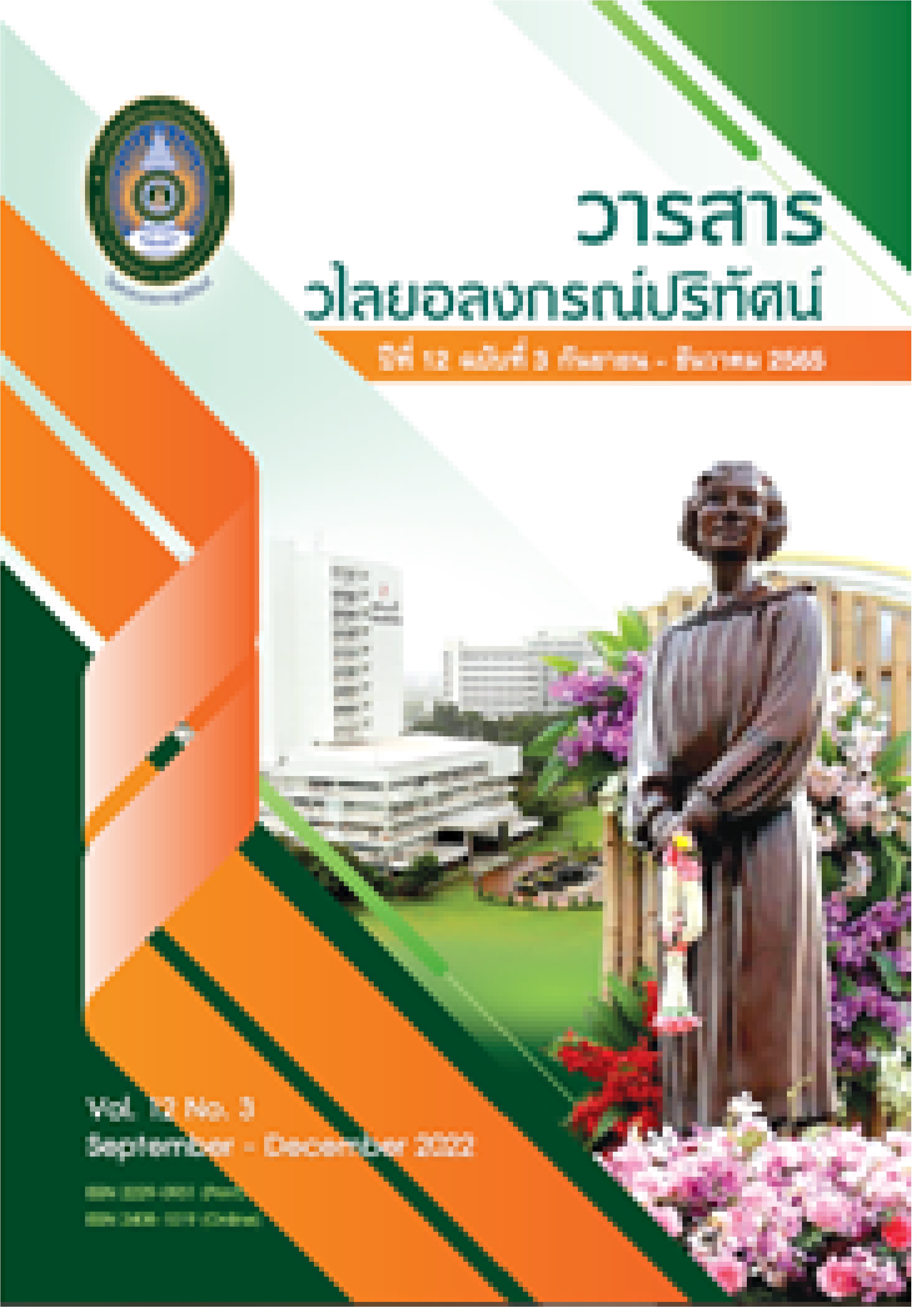การพัฒนาทักษะการฟังและการออกเสียงภาษาอังกฤษด้วยหลักการสอนอ่านแบบโฟนิกส์สังเคราะห์ โดยใช้วิธีการสอน Jolly Phonics
คำสำคัญ:
ทักษะการฟังภาษาอังกฤษ, การออกเสียงภาษาอังกฤษ, การสอนแบบโฟนิกส์สังเคราะห์, การสอนแบบ Jolly Phonicsบทคัดย่อ
ภาษาอังกฤษเป็นเครื่องมือที่มีความสำคัญต่อยุคที่เทคโนโลยีมีความก้าวล้ำนำสมัยและการเดินทางเป็นไปอย่างไร้พรมแดน ทุกคนล้วนจำเป็นต้องใช้ภาษาอังกฤษในการฟังและพูดสื่อสาร โดยทักษะการฟังและการออกเสียงภาษาอังกฤษที่ถูกต้องสามารถเพิ่มความชัดเจนให้ผู้ฟังสามารถฟังได้เข้าใจยิ่งขึ้น และผู้พูดสามารถพูดให้เข้าใจยิ่งขึ้น มั่นใจมากขึ้น และทำให้การสื่อสารประสบความสำเร็จ การสื่อสารด้วยภาษาอังกฤษที่ประสบความสำเร็จจะช่วยเพิ่มโอกาสและความร่วมมือในระดับนานาชาติได้ หากแต่คนไทยส่วนใหญ่มีปัญหาการฟังและการออกเสียงภาษาอังกฤษ เนื่องจากการออกเสียงในภาษาไทยและภาษาอังกฤษแตกต่างกันส่งผลให้ การออกเสียงภาษาอังกฤษของคนไทยมีความคลาดเคลื่อนและเป็นอุปสรรคต่อการสื่อสาร โดยเสียงในภาษาอังกฤษที่คนไทยมีปัญหา คือเสียงที่ไม่มีในภาษาไทย เช่น การออกเสียงตำแหน่งท้ายคำในภาษาอังกฤษ เนื่องจากภาษาไทยส่วนใหญ่ไม่ออกเสียงท้ายคำ ดังนั้นการจะพัฒนาทักษะการฟังและการออกเสียงภาษาอังกฤษ จึงจำเป็นต้องอาศัยการสอนที่มีความแตกต่างไปจากการเรียนภาษาอังกฤษแบบท่องจำและพูดตามเพียงอย่างเดียว หากแต่เป็นการสอนด้วยการเริ่มจากการเข้าใจการออกเสียงตั้งแต่หน่วยเสียงและวิธีการออกเสียงที่ถูกต้อง ฝึกทักษะการฟังในระดับหน่วยเสียงและแยกแยะเสียง ประสมเสียง และอ่านคำศัพท์ใหม่ได้โดยไม่ต้องท่องจำด้วยหลักการเรียนออกเสียงแบบโฟนิกส์สังเคราะห์ (Synthetic Phonics) ควบคู่กับวิธีการสอนการอ่านออกเสียง การเขียนตัวอักษร และวิธีการอ่านออกเสียงที่สนุกสนาน น่าสนใจอย่าง Jolly Phonics ที่ถูกบรรจุในหลักสูตรแกนกลางการศึกษาขั้นพื้นฐานของประเทศอังกฤษและสหรัฐอเมริกา เนื่องจากเป็นการเรียนลักษณะห้องเรียนภาษาที่ไม่กดดันและเป็นพื้นที่ปลอดภัย ทำให้การเรียนรู้ของผู้เรียนดำเนินไปโดยปราศจากความกลัวในการออกเสียงผิด ผู้เรียนเกิดความกล้าและมั่นใจในการเรียนออกเสียงภาษาอังกฤษ
เอกสารอ้างอิง
กานต์ธีรา ภูริวิกรัย. (2564). อุตสาหกรรม ‘ไอโอ’: ภัยคุกคามประชาธิปไตยในศตวรรษที่ 21. [Online] Available at: https://www.the101.world/cyber-troop-2020/ (8 August 2022)
ชายุดา จันทะปิดตา. (2556). การพัฒนาแบบฝึกเสริมทักษะการฟังภาษาอังกฤษเพื่อการสื่อสาร สำหรับนักเรียนชั้นมัธยมศึกษาชั้นปีที่ 4 โรงเรียนบัวหลวงวิทยาคม จังหวัดบุรีรัมย์. Veridian E-Journal Graduate School, Silpakorn University ฉบับมนุษยศาสตร์ปละสังคมศาสตร์. (6)2: 197-211.
ถิรวัฒน์ ตันทนิส. (2556). ปัญหาการออกเสียงภาษาอังกฤษของนักศึกษาสหวิทยาการชั้นปีที่ 3.มหาวิทยาลัยธรรมศาสตร์. ในการประชุมทางวิชาการของมหาวิทยาลัยเกษตรศาสตร์. ครั้งที่ 51. 5-7 กุมภาพันธ์ 2556. (170-177). กรุงเทพฯ: มหาวิทยาลัยเกษตรศาสตร์.
รักษมน ยอดมิ่ง. (2560). การสอนออกเสียงภาษาอังกฤษของครูภาษาอังกฤษระดับประถมศึกษาในจังหวัดพระนครศรีอยุธยา. Veridian E-Journal,Silpakorn University ฉบับภาษาไทย สาขามนุษยศาสตร์สังคมศาสตร์และศิลปะ. 10(1): 1216-1226.
อรรชนิดา หวานคง. (2559). English Teaching in the 21st Century. Journal of Yanasangvorn Research Institute Mahamakut Buddhist University. 7(2): 303–314. Retrieved from https://so04.tci-thaijo.org/index.php/yri/article/view/184935
ASEAN Secretariat. (2021). ASEAN Annual Report 2020-2021 – We care, We Prepare, We Prosper Jakarta, ASEAN Secretariat, July 2021. Jakarta: ASEAN Secretariat.
Bigelow, M. & Schwarz, R. L. (2010). Adult English Language Learners with Limited Literacy. Washington, DC: National Institute for Literacy.
Cormack, P. (2011). Reading pedagogy, "Evidence" and education policy: Learning from history?. The Australian Educational Researcher. 38: 133-148. DOI:10.1007/s13384-011-0020-1.
Derwing, T. & Munro, M. (2022). Pronunciation Learning and Teaching. DOI:10.4324/9781003022497-14.
Dominic, W. & Usha, G. (2008). Synthetic phonics and the teaching of reading. British Educational Research Journal. 34(6): 691-710, DOI: 10.1080/01411920802268912
Eyring, J. L. (2014). Adult ESL Education in the US. The CATESOL Journal. 26(1): 120-149. http://www.catesoljournal.org/wp-content/uploads/2014/10/CJ26_eyring.pdf
Gilakjani, A. P., & Ahmadi, M. R. (2011). Why is pronunciation so difficult to learn? Canadian Center of Science and Education Journal. 4(3): 74-83. https:// doi:10.5539/elt.v4n3p74.
Glazzard, J. (2017). Assessing reading development through systematic synthetic phonics. English in Education. 51(1): 44-57. DOI:10.1111/17548845.2017.11912590
Hepplewhite, D. (2012). The English Alphabetic Phonics. [Online], Available: http://www.phonicsinternational.com/Training_illustrated_The%20English%20Alphabetic%20Code.pdf. (2022, 3 July).
Hinkel, E. (2011). Handbook of Research in Second language teaching and learning 1st Ed. New York: Routledge.
Hornby, A. S., Lea, D., Bradbery, J., & Oxford University Press. (2020). Oxford advanced learner's dictionary of current English. Oxford University Press
Jennifer, B. (2018). Systematic synthetic phonics. Fivefromfive Research Brief2. [Online], Available: https://fivefromfive.com.au/wp-content/uploads/2018/07/rb2.pdf. (2022, 5 March)
Johnston, R. S., McGeown, S., & Watson, J. E. (2012). Long-term effects of synthetic versus analytic phonics teaching on the reading and spelling ability of 10 year old boys and girls. Reading and Writing. 25(6): 1365-1384.
Johnston, R. S., Watson, J. E., & Logan, S. (2009). Enhancing word reading, spelling and reading comprehension skills with synthetic phonics teaching: Studies in Scotland and England. In Contemporary perspectives on reading and spelling. 233-250. Routledge.
Jolly Learning. (2022). Hear the Letter Sounds! [Online], Available: https://www.jollylearning.co.uk/resource-bank/learn-the-letter-sounds/ (2022, 20 January).
Kelly, G. (2001). How to teach pronunciation. (J. Harmer, Ed.). Pearson Education Limited.
Kirsten, S. (2009). Teaching Pronunciation to Adult English Language Learners. CAELA Network Brief. [Online], Available: https://www.camdencountylibrary.org/sites/default/files/files/TeachingPronunciation%20-%20CAL%20pdf.pdf. (2022, 20 January).
Kök, I. (2017). Relationship between Listening Comprehension Strategy Use and Listening Comprehension Proficiency. International Journal of Listening. 32: 1-17. DOI:10.1080/10904018.2016.1276457.
Likitrattanaporn, W. (2014). Teaching Phonological Accuracy and Communicative Fluency at Thai Secondary Schools. English Language Teaching. 7(2): 1-10.
Limsukhawat, S., Kaewyoun, S., Wongwatkit, C., & Wongta, J. (2016). A development of augmented reality-supported mobile game application based on jolly phonics approach to enhancing English phonics learning performance of ESL learners. In Proceedings of the 24th International Conference on Computers in Education. India: Asia-Pacific Society for Computers in Education.
Lloyd, S. (2010). The Phonics Handbook. England: Jolly Learning Ltd.
Milliner, B. & Dimoski, B. (2021). The effects of a metacognitive intervention on lower- proficiency EFL learners' listening comprehension and listening self-efficacy. Language Teaching Research. DOI:10.1177/13621688211004646.
Morley, C. (2022). Listening: Top down and bottom up. [online] Available at: <https://www.teachingenglish.org.uk/article/listening-top-down-and-bottom> (2022, March 25).
Piaget, J. (1971). The theory of stages in cognitive development. In D. R. Green, M. P. Ford, & G. B. Flamer. Measurement and Piaget. McGraw-Hill.
Pinyonatthagarn, D. (2016). ASEAN Community and Thailand’s Need for English Proficiency for Better Job Opportunities. ในการประชุมวิชาการระดับชาติและนานาชาติ Rajabhat University National and International Research and Academic Conference (RUNIRAC IV). ครั้งที่ 4. 22-24 พฤศจิกายน 2559. (32-40). บุรีรัมย์: มหาวิทยาลัยราชภัฏบุรีรัมย์.
Pourhosein, G. A. (2012). The Significance of Pronunciation in English Language Teaching. English Language Teaching (5). DOI:10.5539/elt.v5n4p96.
Roach, P. (2009). English Phonetics and Phonology: A Practical Course. Cambridge: Cambridge University Press.
Robin, R. (2007). Learner-based listening and technological authenticity. Language Learning & Technology. 11(1):109–115.
Sahatsathatsan, S. (2017). Pronunciation Problems of Thai Students Learning English Phonetics: A Case Study at Kalasin University. Journal of Education, Mahasarakham University. (11)4: 67-84.
Tafarki, M. A., & Bensen, B. H. (2019). Synthetic Phonics: An Evaluation of Pilot Training for Jolly Phonics Instructors in Nigeria. Journal of Research in Applied Linguistics. (Proceedings of the 6th International Conference on Applied Linguistics Issues (ALI 2019). 10th. 19-20 July 2019. (1147-1162). Saint Petersburg: Russia.
Toonsiri, R., & Adipattaranan, N. (2020). Using Phonics Method to Promote English Pronunciation Ability and Vocabulary Knowledge Among Mathayom Suksa 1 Students: การใช้วิธีสอนแบบโฟนิกส์เพื่อส่งเสริมความสามารถในการออกเสียงภาษาอังกฤษและความรู้คำศัพท์ ของนักเรียนชั้นมัธยมศึกษาปีที่ 1. Journal of Education Naresuan University. 22(4): 185–198. https://so06.tci-thaijo.org/index.php/edujournal_nu/article/view/104766
Vandergrift, L. (2016). Listening: theory and practice in modern foreign language competence. LLAS Centre for Languages, Linguistics and Area Studies, University of Southampton. https://www.llas.ac.uk//resources/gpg/67
Ziane, R. (2011). The Role of Listening Comprehension in Improving EFL Learners’ Speaking Skill. Case Study: Second Year Students (LMD) at Biskra University. Master’s Dissertation, Ministry of Higher Education and Scientific Research, Faculty of letters and Foreign Languages, English Devision, University of Biskra. Algeria.
ดาวน์โหลด
เผยแพร่แล้ว
รูปแบบการอ้างอิง
ฉบับ
ประเภทบทความ
สัญญาอนุญาต
ลิขสิทธิ์ (c) 2022 กัญญาเลข ฟูตระกูล

อนุญาตภายใต้เงื่อนไข Creative Commons Attribution-NonCommercial-NoDerivatives 4.0 International License.
ข้อความที่ปรากฏในบทความแต่ละเรื่องในวารสารวไลยอลงกรณ์ปริทัศน์ เป็นความคิดเห็นของผู้นิพนธ์แต่ละท่าน มิใช่เป็นทัศนะและมิใช่ความรับผิดชอบของกองบรรณาธิการจัดทำวารสาร และ
มหาวิทยาลัยราชภัฏวไลยอลงกรณ์ ในพระบรมราชูปถัมภ์


